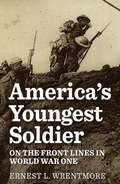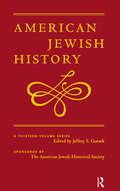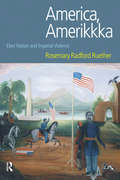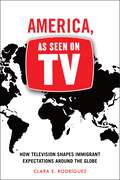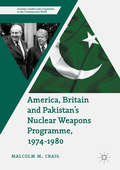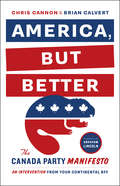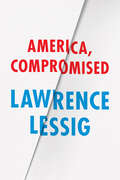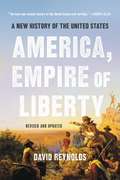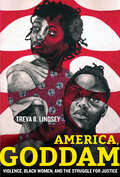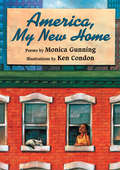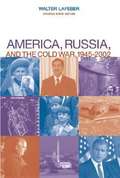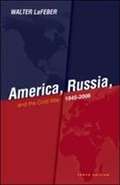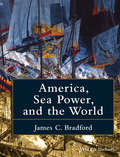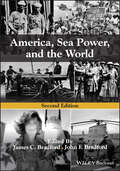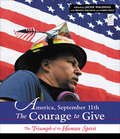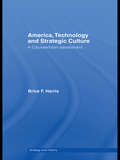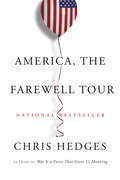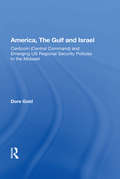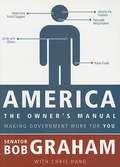- Table View
- List View
America's Youngest Soldier
by Ernest L. WrentmoreAmerica's Youngest Soldier, originally published in 1958 as In Spite of Hell, is the gripping account of Ernest L. Wrentmore, the youngest soldier in the American Expeditionary Force during World War One. Wrentmore served with honor despite his age (two months shy of his thirteenth birthday at the time of his enlistment in September 1917), and despite the horrors he witnessed in the trenches in France. Wrentmore saw front-line service on three battle fronts, and was cited for bravery for delivering a message, under fire, that made it possible for his unit to advance. Wrentmore was wounded twice and severely gassed; and on the night of October 17, 1918, he was evacuated from the field of battle during the first phase of the Meuse-Argonne offensive.
America, American Jews, and the Holocaust: American Jewish History (American Jewish History #4)
by Jeffrey S. GurockThis volume incorporates studies of the persecution of the Jews in Germany, the respective responses of the German-American Press and the American-Jewish Press during the emergence of Nazism, and the subsequent issues of rescue during the holocaust and policies towards the displaced.
America, Amerikkka: Elect Nation and Imperial Violence (Religion and Violence)
by Rosemary Radford RuetherAmerica views itself as a nation inhabiting a "promised land" and enjoying a favoured relation with God. This view of unique election has been coupled with racial exclusivism and the marginalization of non-white citizens.America, Amerikkka traces the historical and ideological patterns behind America’s sense of itself. In its examination of America’s "chosenness", the book ranges across the doctrine of the "rights of man" in the 18th and 19th centuries, the role of America in the twentieth century as "global policeman", and the enforcement of neo-colonial relations over the "third world". The volume argues for a vision of global relations between peoples based on justice and mutuality, rather than hegemonic dominance.
America, América: A New History of the New World
by Greg GrandinA 2025 Kirkus Prize finalist in Nonfiction • Shortlisted for the 2025 Cundill History Prize <BR> “An extraordinarily ambitious book . . . America, América reads at times as the historical equivalent of the great epic novels of Gabriel García Márquez.” —Irish Times <P><P> From the Pulitzer Prize–winning historian, the first comprehensive history of the Western Hemisphere, a sweeping five-century narrative of North and South America that redefines our understanding of both. <P><P> The story of how the United States&’ identity was formed is almost invariably told by looking east to Europe. But as Greg Grandin vividly demonstrates, the nation’s unique sense of itself was in fact forged facing south toward Latin America. In turn, Latin America developed its own identity in struggle with the looming colossus to the north. In this stunningly original reinterpretation of the New World, Grandin reveals how North and South emerged from a constant, turbulent engagement with each other. <P><P> America, América traverses half a millennium, from the Spanish Conquest—the greatest mortality event in human history—through the eighteenth-century wars for independence, the Monroe Doctrine, the coups and revolutions of the twentieth century, and beyond. Grandin shows, among other things, how in response to U.S. interventions, Latin Americans remade the rules, leading directly to the founding of the United Nations; and how the Good Neighbor Policy allowed FDR to assume the moral authority to lead the fight against world fascism. <P><P> Grandin’s book sheds new light on well-known historical figures like Bartolomé de las Casas, Simón Bolívar, and Woodrow Wilson, as well as lesser-known actors such as the Venezuelan Francisco de Miranda, who almost lost his head in the French Revolution and conspired with Alexander Hamilton to free America from Spain; the Colombian Jorge Gaitán, whose unsolved murder inaugurated the rise of Cold War political terror, death squads, and disappearances; and the radical journalist Ernest Gruening, who, in championing non-interventionism in Latin America, helped broker the most spectacularly successful policy reversal in United States history. <P><P> This is a monumental work of scholarship that will fundamentally change the way we think of Spanish and English colonialism, slavery and racism, and the rise of universal humanism. At once comprehensive and accessible, America, América shows that centuries of bloodshed and diplomacy not only helped shape the political identities of the United States and Latin America but also the laws, institutions, and ideals that govern the modern world. In so doing, Grandin argues that Latin America’s deeply held culture of social democracy can be an effective counterweight to today’s spreading rightwing authoritarianism. A culmination of a decades-long engagement with hemispheric history, drawing on a vast array of sources, and told with authority and flair, this is a genuinely new history of the New World. <P><P> <b>New York Times Bestseller</b>•
America, As Seen on TV: How Television Shapes Immigrant Expectations around the Globe
by Clara E. RodríguezFinalist, 2020 Latino Book Awards, Best Academic Themed BookThe surprising effects of American TV on global viewers As a dominant cultural export, American television is often the first exposure to American ideals and the English language for many people throughout the world. Yet, American television is flawed, and, it represents race, class, and gender in ways that many find unfair and unrealistic. What happens, then, when people who grew up on American television decide to come to the United States? What do they expect to find, and what do they actually find? In America, As Seen on TV, Clara E. Rodríguez surveys international college students and foreign nationals working or living in the US to examine the impact of American television on their views of the US and on their expectations of life in the United States. She finds that many were surprised to learn that America is racially and economically diverse, and that it is not the easy-breezy, happy endings culture portrayed in the media, but a work culture. The author also surveys US-millennials about their consumption of US TV and finds that both groups share the sense that American TV does not accurately reflect racial/ethnic relations in the US as they have experienced them. However, the groups differ on how much they think US TV has influenced their views on sex, smoking and drinking. America, As Seen on TV explores the surprising effects of TV on global viewers and the realities they and US millennials actually experience in the US.
America, Britain and Pakistan’s Nuclear Weapons Programme, 1974-1980: A Dream of Nightmare Proportions (Security, Conflict and Cooperation in the Contemporary World)
by Malcolm M. CraigThis book analyses US and UK efforts to shut down Pakistan's nuclear programme in the 1970s, between the catalytic Indian nuclear test of May 1974 and the decline of sustained non-proliferation activity from mid-1979 onwards. It is a tale of cooperation between Washington and London, but also a story of divisions and disputes. The brutal economic realities of the decade, globalisation, and wider geopolitical challenges all complicated this relationship. Policy and action were also affected by changes elsewhere in the world. Iran's 1979 revolution brought a new form of political Islamic radicalism to prominence. The fears engendered by the Ayatollah and his followers, coupled to the blustering rhetoric of Pakistani leaders, gave rise to the 'Islamic bomb', a nuclear weapon supposedly created by Pakistan to be shared amongst the Muslim ummah. This study thus combines cultural, diplomatic, economic, and political history to offer a rigorous, deeply researched account of a critical moment in nuclear history.
America, But Better
by Chris Cannon Brian CalvertAs the American election increasingly resembles a production of CATS performed by actual cats, U.S. citizens are looking for a new leader. That leader is Canada, and they want your vote for president of the United States.Since launching their viral video campaign in January, the Canada Party has been covered around the world, including CNN, BBC, the Huffington Post, and German State Television. America, but Better: the Canada Party Manifesto, balances the doctrine of American exceptionalism with a dose of Canadian humility and common sense to secure Canada as the new leader of the free world, by proxy.Their promises: One gay couple will be allowed to marry for every straight couple that gets divorced. The phrase "job creators" will be changed to "job creationists," and they will be given seven days to actually create some.Corporations will still be people, but if they can't provide a birth certificate they will be legally obligated to care for your lawn. Corners will be installed in the Oval Office, and timeouts given to congressmen who can't play nice.Devoted to restoring America to its former glory, the Canada Party will soon have the whole world chanting, "Yes We Canada."
America, China, and the Struggle for World Order
by G. John Ikenberry Zhu Feng Wang JisiThis book brings together twelve scholars–-six Americans and six Chinese-–to explore the ways America and China think about international order. What are the traditions, historical experiences, and ideologies that each country brings to debates about how the rules and institutions of the global system should be organized? The book addresses this question by pairing American and Chinese scholars in each chapter on specific topics related to global order: sovereignty, collective security, resources and the environment, trade, alliances, and monetary and financial relations. The book offers a vivid portrait of how the two countries come to global affairs from richly diverse and divergent starting points, and, in turn, how these factors affect current global dialogues.
America, Compromised: Five Studies In Institutional Corruption (Berlin Family Lectures)
by Lawrence Lessig“There is not a single American awake to the world who is comfortable with the way things are.” So begins Lawrence Lessig's sweeping indictment of contemporary American institutions and the corruption that besets them. We can all see it—from the selling of Congress to special interests to the corporate capture of the academy. Something is wrong. It’s getting worse. And it’s our fault. What Lessig shows, brilliantly and persuasively, is that we can’t blame the problems of contemporary American life on bad people, as our discourse all too often tends to do. Rather, he explains, “We have allowed core institutions of America’s economic, social, and political life to become corrupted. Not by evil souls, but by good souls. Not through crime, but through compromise.” Every one of us, every day, making the modest compromises that seem necessary to keep moving along, is contributing to the rot at the core of American civic life. Through case studies of Congress, finance, the academy, the media, and the law, Lessig shows how institutions are drawn away from higher purposes and toward money, power, quick rewards—the first steps to corruption. Lessig knows that a charge so broad should not be levied lightly, and that our instinct will be to resist it. So he brings copious, damning detail gleaned from years of research, building a case that is all but incontrovertible: America is on the wrong path. If we don’t acknowledge our own part in that, and act now to change it, we will hand our children a less perfect union than we were given. It will be a long struggle. This book represents the first steps.
America, Empire of Liberty: A New History of the United States
by David ReynoldsIt was Thomas Jefferson who envisioned the United States as a great "empire of liberty. ” This paradoxical phrase may be the key to the American saga: How could the anti-empire of 1776 became the world’s greatest superpower? And how did the country that offered unmatched liberty nevertheless found its prosperity on slavery and the dispossession of Native Americans? In this new single-volume history spanning the entire course of US history-from 1776 through the election of Barack Obama-prize-winning historian David Reynolds explains how tensions between empire and liberty have often been resolved by faith-both the evangelical Protestantism that has energized American politics for centuries and the larger faith in American righteousness that has driven the country’s expansion. Written with verve and insight,Empire of Libertybrilliantly depicts America in all of its many contradictions.
America, Goddam: Violence, Black Women, and the Struggle for Justice
by Treva B. LindseyOne of the Best Nonfiction Books of 2022, Kirkus Reviews "A righteous indictment of racism and misogyny."—Publishers WeeklyA powerful account of violence against Black women and girls in the United States and their fight for liberation. Echoing the energy of Nina Simone's searing protest song that inspired the title, this book is a call to action in our collective journey toward just futures.America, Goddam explores the combined force of anti-Blackness, misogyny, patriarchy, and capitalism in the lives of Black women and girls in the United States today. Through personal accounts and hard-hitting analysis, Black feminist historian Treva B. Lindsey starkly assesses the forms and legacies of violence against Black women and girls, as well as their demands for justice for themselves and their communities. Combining history, theory, and memoir, America, Goddam renders visible the gender dynamics of anti-Black violence. Black women and girls occupy a unique status of vulnerability to harm and death, while the circumstances and traumas of this violence go underreported and understudied. America, Goddam allows readers to understand How Black women—who have been both victims of anti-Black violence as well as frontline participants—are rarely the focus of Black freedom movements. How Black women have led movements demanding justice for Breonna Taylor, Sandra Bland, Toyin Salau, Riah Milton, Aiyana Stanley-Jones, and countless other Black women and girls whose lives have been curtailed by numerous forms of violence. How across generations and centuries, their refusal to remain silent about violence against them led to Black liberation through organizing and radical politics. America, Goddam powerfully demonstrates that the struggle for justice begins with reckoning with the pervasiveness of violence against Black women and girls in the United States.
America, Inc.: Who Owns and Operates the United States
by Jerry S. Cohen Morton Mintz"This well-documented expose' reveals the incorporated rulers of the United States and, indeed, much of the world. It shows them to be private governments which, as effectively as legitimate public governments, decide whether large numbers of us live or die. They levy taxes in the form of price increases, unrestrained by competition. They manipulate legitimate governments, turning nations into welfare states for corporations. And they are generally only responsible to themselves. Thus the citizen is powerless while the conglomerates enforce private socialism and decry public socialism. The authors propose an alternate solution to this seemingly powerless situation."
America, My New Home
by Ken Condon Monica GunningFrom her Caribbean island birthplace, a young girl carries a dream and journeys to a new land that is at once puzzling, frightening, and inspiring. <P><P>In twenty-three compelling poems, Jamaican-born poet Monica Gunning tells her immigrant's story with gentle humor, grace, and a child's sense of wonder. She desribes a place where skyscrapers, rather than the moon, light the night; where people dress in woolens, ready for snow; where no one knows your name. Yet this same place offers exciting treasures: dizzying amusement park rides, stirring symphony concerts, flashy circus performers, towering cathedrals, and captivating art museums that speak to those who linger. Above all, this new land is place where "hope glows, a beacon / guiding ocean-deep dreamers / from storm surfs to shore."
America, Pakistan, And The India Factor
by Nirode MohantyThis book is not just an update to studies of Middle Eastern policy and diplomacy, but an in-depth analysis that covers the United States' foreign and strategic policy from the days of President Roosevelt to President Obama and Pakistan's security and strategic planning since its inception to 2011, under the shadow of India and Afghanistan.
America, Past and Present, Volume 2 10th Edition
by H. W. Brands T. H. Breen Robert A. Divine R. Hal Williams Ariela J. GrossAmerica, Past and Present, Volume 2 focuses students on the story of American history. The book integrates the social and political dimensions of American history into one chronological narrative, providing students with a full picture of the scope and complexity of the American past. It tells the story of all Americans elite and ordinary, women and men, rich and poor, white majority and minorities.
America, Russia, and the Cold War 1945-2002 (Updated Ninth Edition)
by Walter LafeberProfessor LaFeber explains the course of the Cold War as it moved from periods of intense crisis and confrontation to times of relative stability.
America, Russia, and the Cold War, 1945-2006 (Tenth Edition)
by Walter LafeberUsing extensive materials from both published and private sources, this concise text focuses on United States-Soviet diplomacy to explain the causes and consequences of the Cold War. It explores how the Cold War was shaped by domestic events in both the U. S. and the Soviet Union and presents a variety of other points of view on the conflict--Chinese, Latin American, European, and Vietnamese. The text includes both engaging anecdotes and quotes from primary sources to support key points and exemplify policies, and recent scholarship and materials from openings of the U. S. , Soviet, and Chinese archives.
America, Sea Power, and the World
by James C. BradfordThis survey of American naval history features original chapters from key scholars in the field that trace the relationship between the American Navy and the position of the United States on the global political stage over the past 250 years. Places equal weight on the influence of major wartime campaigns and naval efforts to defend and expand America’s political and economic interests during times of peace Includes an array of illustrations and 56 new maps, seamlessly integrated within each chapter Each chapter features sidebars with biographical sketches of influential leaders and descriptions of weapons and technological developments of the era
America, Sea Power, and the World
by James C. Bradford John F. BradfordThe gold standard in college-level American naval history texts, edited by the foremost scholar in the field In the newly revised second edition of America, Sea Power and the World, a team of distinguished researchers delivers an extensive and authoritative survey of American naval history, the place of the United States in world affairs, and the role of that country’s naval forces during peacetime and wartime. Each chapter contains a comprehensive analysis of its subject as well as brief sidebars describing a key weapon or technological development of the era and a short biographical sketch of an influential leader or representative of the navy from that era. The book offers extensive illustration and maps and a throughgoing emphasis on naval policy, strategy, roles, and missions, with careful attention paid to naval operations. These factors given greater focus than the descriptions of battle tactics found in other texts. Readers will also find: A thorough introduction to sea power and the modern state system, as well as the American War for Independence at sea Comprehensive explorations of the genesis of the United States Navy from 1785 to 1806 Practical discussions of the Naval War of 1812 and the Confirmation of Independence from 1807 to 1815 and the Squadron Navy as an agent of the commercial empire until 1890 Fulsome treatments of the Second World War in the Atlantic, Mediterranean, and the Pacific, including defensive actions in the Pacific from 1937 to 1943 and offensive actions from 1943 to 1944. New chapters exclusive to the 2nd edition focused on the history of African Americans and women in the US Navy, the development of joint operations and unified command, and the naval history of the last two decades.Perfect for undergraduate students taking courses on the naval history of the United States, America, Sea Power and the World, Second Edition will also earn a place in the libraries of members of the general public interested in naval and military history.
America, September 11th: The Triumph of the Human Spirit (Call to Action Books)
by Karen Frost Brenda WelchlinTrue stories of compassion, heroism, and kindness in the midst of a historic tragedy.Every tragedy has its heroes, and there were many in the terrorist attacks on New York City and Washington, D.C., on 9/11 and in the difficult days that followed. In this inspiring volume, Jackie Waldman, author of The Courage to Give, has collected the dramatic stories of some of the firefighters, rescue workers, police, medics, relatives searching for missing loved ones, and everyday people who, in the face of horror, sprang into action to save lives and help their communities. From the ASPCA leader who lost a sister that day and went on to lead an effort to rescue abandoned pets from the area, to the music student who went to Ground Zero to play for the toiling rescue workers, these vivid accounts, written in the immediate aftermath, paint a vivid picture of that infamous event—and remind us of what is best in us even in the worst of times.
America, Technology and Strategic Culture: A Clausewitzian Assessment (Strategy And History Ser. #Vol. 23)
by Brice HarrisThis book analyses the American way of war within the context of Clausewitzian theory. In doing so, it draws conclusions about the origins, viability, and technical feasibility of America‘s current strategic approach.The author argues that the situation in which America has found itself in Iraq is the direct result of a culturally predisposed incli
America, The Farewell Tour
by Chris HedgesIf you thought you knew Chris Hedges--be surprised. The globally renowned Pulitzer Prize-winner gives us an entirely new view of a nation in crisis in a stunning book that holds both liberals and conservatives to account--as rousingly pertinent for Canada as for the disoriented US. Beautifully written, it clarifies vividly and unforgettably the forces at play in our times.In astonishing, tough, first-hand reportage, Chris Hedges draws on stories from inside communities across America and reveals how the hurricanes of change have allowed an array of pathologies to arise: the opioid crisis, the retreat into gambling, the corporate coup d'état of government, the pornification of culture, the rise of magical thinking, the emboldening of violence and hate, the plagues of suicides, and the global upheaval caused by catastrophic climate change. These are just some of the physical manifestations of a society unravelling. Such ills presage a frightening reconfiguration of our lives--particularly in the face of our neighbour's degeneration as a world power.Donald Trump rode this disenchantment to power. Hedges--who was unsurprised by Trump's victory--shows how neither the left nor the right are addressing the systemic problems. Until the corporate coup d'état is reversed, these diseases will grow and ravage the country. A humane cry for a decent future, this remarkable book is our wake-up call to reality.
America, The Gulf, And Israel: Centcom (central Command) And Emerging U.s. Regional Security Policies In The Middle East
by Dare GoldThis book evaluates whether the military preparations made by US in the aftermath of Central Command's (CENTCOM) establishment, represent the kind of change in America's military relationship with the Middle East. It also evaluates the implications of the creation of CENTCOM for US-Israel relations.
America, The Owner's Manual: Making Government Work for You
by Bob Graham Chris HandWatch Senator Graham on The Colbert Report! The Colbert ReportMon - Thurs 11:30pm / 10:30cShe Said, CIA Said - Bob Grahamcolbertnation. com Click here to preview chapter 1. Professors: Order your exam copy today by clicking on the &BAD:"Request an Exam Copy&BAD:" link above. Would you teach someone to play basketball using just chalkboard diagrams? Or would you get them on the court and have them play? In basketball, the answer is easy&BAD:—you do both. So why teach politics only as a spectator sport?Senator Bob Graham believes that students should expand on their classroom learning about the political system: he spurs them to hit the court and actually play the game. If students work on an issue they care about, politics will become a meaningful and positive experience. This short, how-to guide takes students out of theoretical discussions of policy and into a world where they can affect change. Graham&BAD:’s goal is to have students identify a problem, and then walk them through each step from researching the issue, to getting others involved, to engaging the media. Each chapter starts with a real case, showing citizens tackling a step in the process, and ends with a summary checklist and a series of questions that help students put Graham&BAD:’s game plan in action. By offering students concrete guidance, an array of resources, and advice for troubleshooting and overcoming barriers, this compact user&BAD:’s guide gets students way beyond textbook learning. Thirty-five years ago, as a member of the Florida Legislature, Bob Graham took on the challenge of civic education for eighteen weeks at a Miami-area high school. His time as both a governor and a senator has only strengthened his resolve to pique students&BAD:’ curiosity about politics and teach them to get what they want from government.
